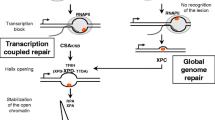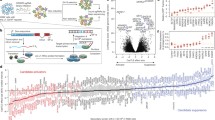Abstract
LINE-1 (L1) retrotransposons comprise about 17% of the human genome and include a recently transposed set of Ta-L1 elements that are polymorphic in humans. Although it is widely believed that L1s play an essential role in shaping and functioning of mammalian genomes, the understanding of the impact of L1 insertions on gene expression is far from being comprehensive. Here we compared hnRNA contents for allele pairs of genes heterozygous for Ta-L1 insertions in their introns in human cell lines of various origin. We demonstrated that some Ta-L1 insertions correlated with decreased content of the corresponding hnRNAs. This effect was characteristic of only nearly full-sized L1s and seemed to be tissue specific.
Similar content being viewed by others
References
S. Boissinot A. Entezam L. Young P. J. Munson A. V. Furano (2004) ArticleTitleThe insertional history of an active family of L1 retrotransposons in humans Genome Res. 14 IssueID7 1221–1231 Occurrence Handle15197167 Occurrence Handle1:CAS:528:DC%2BD2cXlvFWjsbw%3D Occurrence Handle10.1101/gr.2326704
A. Buzdin S. Ustyugova E. Gogvadze Y. G. Lebedev Hunsmann et al. (2003) ArticleTitleGenome-wide targeted search for human specific and polymorphic L1 integrations Hum Genet. 112 IssueID5–6 527–533 Occurrence Handle12601470 Occurrence Handle1:CAS:528:DC%2BD3sXivVOgtrw%3D
A. V. Furano D. D. Duvernell S. Boissinot (2004) ArticleTitleL1 (LINE-1) retrotransposon diversity differs dramatically between mammals and fish Trends Genet. 20 IssueID1 9–14 Occurrence Handle14698614 Occurrence Handle1:CAS:528:DC%2BD3sXpvFyrsbs%3D Occurrence Handle10.1016/j.tig.2003.11.006
J. L. Goodier E. M. Ostertag H. H. Kazazian SuffixJr. (2000) ArticleTitleTransduction of 3’-flanking sequences is common in L1 retrotransposition Hum. Mol. Genet. 9 IssueID4 653–657 Occurrence Handle10699189 Occurrence Handle1:CAS:528:DC%2BD3cXhvVGnurs%3D Occurrence Handle10.1093/hmg/9.4.653
J. S. Han J. D. Boeke (2004) ArticleTitleA highly active synthetic mammalian retrotransposon Nature 429 IssueID6989 314–318 Occurrence Handle15152256 Occurrence Handle1:CAS:528:DC%2BD2cXktVOqur4%3D Occurrence Handle10.1038/nature02535
J. S. Han S. T. Szak J. D. Boeke (2004) ArticleTitleTranscriptional disruption by the L1 retrotransposon and implications for mammalian transcriptomes Nature 429 IssueID6989 268–274 Occurrence Handle15152245 Occurrence Handle1:CAS:528:DC%2BD2cXktVOqur0%3D Occurrence Handle10.1038/nature02536
H. H. Kazazian SuffixJr. (2004) ArticleTitleMobile elements: drivers of genome evolution Science 303 IssueID5664 1626–1632 Occurrence Handle15016989 Occurrence Handle1:CAS:528:DC%2BD2cXhvFCntrk%3D Occurrence Handle10.1126/science.1089670
E. S. Lander L. M. Linton B. Birren C. Nusbaum M. C. Zody et al. (2001) ArticleTitleInitial sequencing and analysis of the human genome Nature 409 IssueID6822 860–921 Occurrence Handle11237011 Occurrence Handle1:CAS:528:DC%2BD3MXhsFCjtLc%3D Occurrence Handle10.1038/35057062
L. Lavie E. Maldener B. Brouha E. U. Meese J. Mayer (2004) ArticleTitleThe human L1 promoter: variable transcription initiation sites and a major impact of upstream flanking sequence on promoter activity Genome Res. 14 IssueID11 2253–2260 Occurrence Handle15520289 Occurrence Handle1:CAS:528:DC%2BD2cXpvVCitbk%3D Occurrence Handle10.1101/gr.2745804
H. S. Lo Z. Wang Y. Hu H. H. Yang S. Gere et al. (2003) ArticleTitleAllelic variation in gene expression is common in the human genome Genome Res. 13 IssueID8 1855–1862 Occurrence Handle12902379 Occurrence Handle1:CAS:528:DC%2BD3sXmsVWqtLw%3D
T. Miller K. Williams R. W. Johnstone A. Shilatifard (2000) ArticleTitleIdentification, cloning, expression, and biochemical characterization of the testis-specific RNA polymerase II elongation factor ELL3 J. Biol. Chem. 275 IssueID41 32052–32056 Occurrence Handle10882741 Occurrence Handle1:CAS:528:DC%2BD3cXnsFejsbg%3D Occurrence Handle10.1074/jbc.M005175200
R. Minakami K. Kurose K. Etoh Y. Furuhata M. Hattori et al. (1992) ArticleTitleIdentification of an internal cis-element essential for the human L1 transcription and a nuclear factor(s) binding to the element Nucl. Acid Res. 20 IssueID12 3139–3145 Occurrence Handle1:CAS:528:DyaK38XlsVClsrs%3D
J. S. Myers B. J. Vincent H. Udall W. S. Watkins T. A. Morrish et al. (2002) ArticleTitleA comprehensive analysis of recently integrated human Ta L1 elements Am. J. Hum. Genet. 71 IssueID2 312–326 Occurrence Handle12070800 Occurrence Handle1:CAS:528:DC%2BD38XlvV2qtLY%3D Occurrence Handle10.1086/341718
P. Nigumann K. Redik K. Matlik M. Speek (2002) ArticleTitleMany human genes are transcribed from the antisense promoter of L1 retrotransposon Genomics 79 IssueID5 628–634 Occurrence Handle11991712 Occurrence Handle1:CAS:528:DC%2BD38Xjt12qtrg%3D Occurrence Handle10.1006/geno.2002.6758
E. M. Ostertag H. H. Kazazian SuffixJr. (2001) ArticleTitleBiology of mammalian L1 retrotransposons Annu. Rev. Genet. 35 501–538 Occurrence Handle11700292 Occurrence Handle1:CAS:528:DC%2BD38XlsVOg Occurrence Handle10.1146/annurev.genet.35.102401.091032
V. Perepelitsa-Belancio P. Deininger (2003) ArticleTitleRNA truncation by premature polyadenylation attenuates human mobile element activity Nat. Genet. 35 IssueID4 363–366 Occurrence Handle14625551 Occurrence Handle1:CAS:528:DC%2BD3sXpt1Ciu7o%3D Occurrence Handle10.1038/ng1269
O. K. Pickeral W. Makalowski M. S. Boguski J. D. Boeke (2000) ArticleTitleFrequent human genomic DNA transduction driven by LINE-1 retrotransposition Genome Res. 10 IssueID4 411–415 Occurrence Handle10779482 Occurrence Handle1:CAS:528:DC%2BD3cXjtVKrsrc%3D Occurrence Handle10.1101/gr.10.4.411
J. Sambrook D. W. Russel (2001) Molecular Cloning: a Laboratory Manual Cold Spring Harbor Laboratory Press Cold Spring Harbor, NY
T. Tchenio J. F. Casella T. Heidmann (2000) ArticleTitleMembers of the SRY family regulate the human LINE retrotransposons Nucl. Acid Res. 28 IssueID2 411–415 Occurrence Handle1:CAS:528:DC%2BD3cXhtVSkt74%3D Occurrence Handle10.1093/nar/28.2.411
S. V. Ustyugova A. L. Amosova Y. L. Lebedev E. D. Sverdlov (2005) ArticleTitleCell line fingerprinting using retroelement insertion polymorphism Biotechniques 38 IssueID4 561–565 Occurrence Handle15884674 Occurrence Handle1:CAS:528:DC%2BD2MXjsFWms7c%3D Occurrence Handle10.2144/05384ST02
R. H. Waterston K. Lindblad-Toh E. Birney J. Rogers J. F. Abril et al. (2002) ArticleTitleInitial sequencing and comparative analysis of the mouse genome Nature 420 IssueID6915 520–562 Occurrence Handle12466850 Occurrence Handle1:CAS:528:DC%2BD38Xpt1WhsLw%3D Occurrence Handle10.1038/nature01262
Q. Xu T. Nakanishi K. Sekimizu S. Natori (1994) ArticleTitleCloning and identification of testis-specific transcription elongation factor S-II J. Biol. Chem. 269 IssueID4 3100–3103 Occurrence Handle8300645 Occurrence Handle1:CAS:528:DyaK2cXis1amsb8%3D
H. Yan W. Yuan V. E. Velculescu B. Vogelstein K. W. Kinzler (2002) ArticleTitleAllelic variation in human gene expression Science 297 IssueID5584 1143 Occurrence Handle12183620 Occurrence Handle1:CAS:528:DC%2BD38XmsVOiu7s%3D Occurrence Handle10.1126/science.1072545
N. Yang L. Zhang Y. Zhang H. H. Kazazian SuffixJr. (2003) ArticleTitleAn important role for RUNX3 in human L1 transcription and retrotransposition Nucl. Acid Res. 31 IssueID16 4929–4940 Occurrence Handle1:CAS:528:DC%2BD3sXmtFKrt7w%3D Occurrence Handle10.1093/nar/gkg663
Author information
Authors and Affiliations
Corresponding author
Rights and permissions
About this article
Cite this article
Ustyugova, S.V., Lebedev, Y.B. & Sverdlov, E.D. Long L1 insertions in human gene introns specifically reduce the content of corresponding primary transcripts. Genetica 128, 261–272 (2006). https://doi.org/10.1007/s10709-005-5967-2
Received:
Accepted:
Issue Date:
DOI: https://doi.org/10.1007/s10709-005-5967-2




